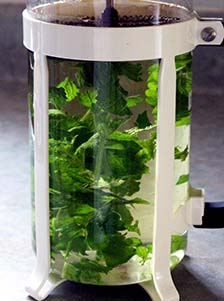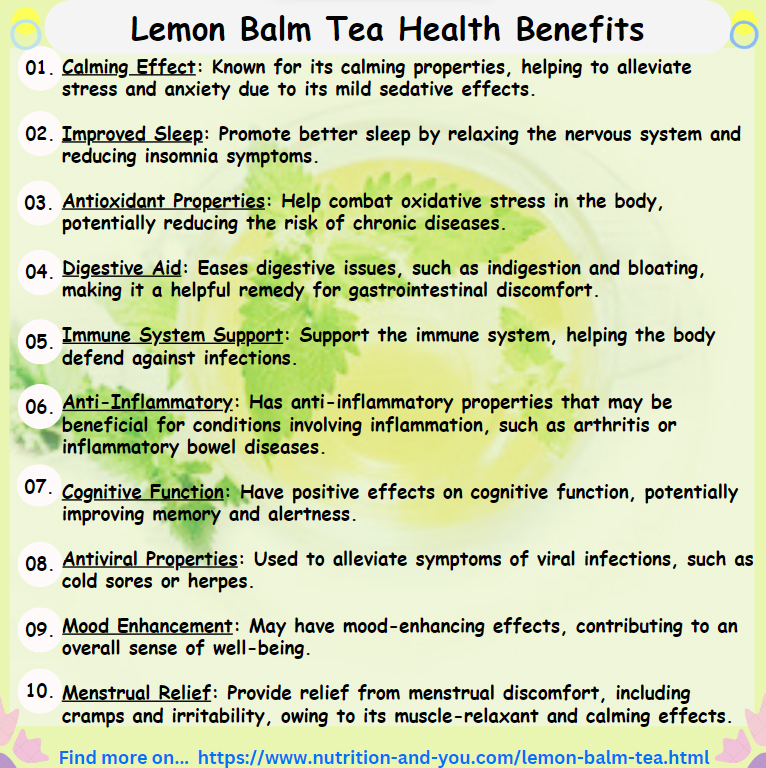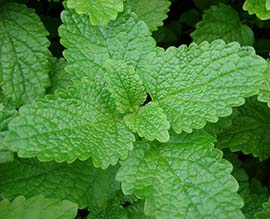Lemon balm tea Nutrition facts
Lemon balm tea is a natural herbal tranquilizer to soothe troubling nervous systems! The infusion is prepared by using fresh or dried leaves and shoots of the lemon balm plant.
Balm is an aromatic plant closely related to mint in the Mentheae tribe; the largest tribe of plants in the Lamiaceae family which also includes herbs such as sage, spearmint and thyme. The herb is called lemon balm because of the characteristic lemony smell emitted by its leaves when bruised.
The herb is thought to have originated in Southern Europe, around the Mediterranean. It grows in the wild in different temperate regions around the world. It is also called balm mint, sweet balm or just balm.
Scientific name: Melissa officinalis.
 |
| Lemon balm tea. Photo courtesy: Andrea_44 |
The plant is a clump-forming, herbaceous perennial with creeping roots and erect square branching stems that grow 30 to 50 cm tall. Its heart-shaped, lemon-fragrant leaves feature crinkled, serrated leaf surfaces and deep venation. The upper surface of the leaves is covered by tiny hairs. White, yellowish, pale pink flowers in spikes emerge in between the leaf axils during late summer. The blooms develop into fruit pods bearing long oval seeds.
The herb grows best in rich moist soil in full sun or light shade. To grow, sow seeds in spring. Trim the plant in spring before flowering to encourage foliage.
10 Amazing Health Benefits of Lemon Balm tea
Lemon balm is a zero-calorie herb. Its shoots and stems carry several health-benefiting essential oils and other anti-oxidant phytochemical compounds.
Balm leaves contain many essential oils terpenes like citral (lemonol), citronellol, caryophyllene, linalool, citronellal, and polyphenols like eugenol and geranial, and tannins. These compounds together give an anti-viral, nerve-soothing effect and a special lemon-like aroma to the herb.
These essential oils possess carminative, tonic, anthelmintic, antispasmodic, and digestive properties.
Research studies suggest that the chemical compounds in the balm herb infusion possess calming and relaxing effects on the nervous system. It helps relieve fatigue, headaches, nervousness, and giddiness.
Its infusion is advocated as a "memory booster" in traditional medicines to alleviate nervousness, insomnia, and cognitive problems. Its cognitive function strengthening can be a boon in people with Alzheimer's disease.
Certain compounds in the balm are also known to have carminative and anti-spasmodic actions. Thus, fresh balm infusion can improve appetite, and when taken after meals may help reduce gastric ailments, flatulence, and colicky pains.
Medicinally, balm infusion helps lower blood pressure, and improve heart function and circulation.
Research studies suggest that compounds in lemon balm extraction suppress the production of a thyroid-stimulating hormone (TSH). It thus, makes it useful in treating certain hyperthyroid disorders like Grave's disease.
Pharmaceutically, sweet balm essential oil and liquid extracts have been shown to possess strong antibacterial and antiviral qualities, particularly against cold sores infection caused by herpes simplex virus (HSV).(Medical disclaimer).
Further, lemon balm tea is a caffeine-free drink. Its regular consumption could alleviate morning sickness, nausea, and heartburn.
 |
| Principle | Nutrient Value | Percent of RDA |
|---|---|---|
| Energy | 1 Kcal | 0% |
| Carbohydrates | 0.20 g | <1% |
| Protein | 0 g | 0% |
| Total Fat | 0 g | 0% |
| Cholesterol | 0 mg | 0% |
| Dietary Fiber | 0 g | 0% |
| Vitamins | ||
| Folates | 1 µg | 0.25% |
| Niacin | 0 mg | 0% |
| Pyridoxine | 0 mg | 0% |
| Riboflavin | 0.004 mg | <1% |
| Thiamin | 0.010 mg | <1% |
| Vitamin A | 0 IU | 0% |
| Vitamin-C | 0 mg | 0% |
| Electrolytes | ||
| Sodium | 1 mg | <1% |
| Potassium | 9 mg | <1% |
| Minerals | ||
| Calcium | 2 mg | 0.2% |
| Iron | 0.08 mg | 1% |
| Magnesium | 1 mg | <1% |
| Zinc | 0.04 mg | 1<1% | Phyto-nutrients |
| Caffeine | 0 mg | -- |
Selection and storage
 |
| Lemon balm-Melissa officinalis. Photo courtesy: Forest and Kim Starr |
Fresh lemon herb leaves can be available all around the year. The herb can be grown in much similar like other Mentheae tribe herbs like peppermint, savory, oregano, etc. It can be grown in pots, as a garden herb, or cultivated on a larger scale as a field crop for the purpose of extraction of essential oils.
In the herbal stores, sweet balm leaves; fresh or dried can be readily available. Choose fresh balm with firm stems and leaves without any dark spots.
Store fresh leaves for short-term use in a plastic bag inside the home refrigerator, and dry leaves in air-seal containers.
Once at home, wash the leaves in clean running water, and pat dry using an absorbent towel.
Preparation of lemon balm tea
To make an infusion, loosely fill the cup with a handful of roughly chopped fresh leaves of balm mint. Add (150 ml) of hot water, and steep for 10-12 minutes. You can also put a teaspoonful of dried leaves instead. Drink up to 3 cups a day.
Lemon balm is often combined with other soothing herbs, such as verbena, chamomile, and hibiscus, to relieve depression and calm mood.
In addition to popular tisane, lemon balm can also be much sought after in cooking as a potherb, garnish, and flavoring drink.
It is added in small amounts, chopped, or ground (paste) to recipes at the last moments of cooking to retain its flavor and prevent the evaporation of essential oils.Here are some serving tips:
Its fresh leaves are used to impart a refreshing lemony flavor to drinks, teas, and fruit juices.
Lemon balm is used fresh or dried. It is a good accompaniment to pungent, bitter foods.
The herb is highly sought after by chefs to flavor curries, soups, and sauces.
Frsh leaves employed in vegetable and fruit salads, stuffing, bean dishes, and marinades for meat, poultry, and seafood.
The herb is also employed in many Northern European countries to flavor and marinate seafood, eel, and herring.
Safety profile
Consumption of lemon balm tea is considered safe in children and pregnant women in moderate quantities. It may alter the dosage of medications in patients on anti-thyroid and sedative drugs. People on these medications should consult a physician before taking lemon balm. (Medical disclaimer).
≻≻-Read Health benefits of Chamomile tea.
≻≻-Read Health benefits of Rooibos tea.
≻≻-Back to Herbal teas from Lemon Balm tea. Visit here for an impressive list of all variety of herbal tea with complete illustrations of their nutrition facts and health benefits.
≻≻-Back to Home page.
Further Resources:
USDA National Nutrient Database. (opens in new window).
Stanford School of Medicine Cancer information Page-Nutrition to Reduce Cancer Risk (Link opens in new window).
University of Maryland Medical center-Lemon balm (Link opens in new window).